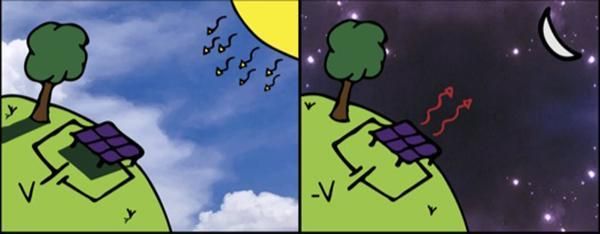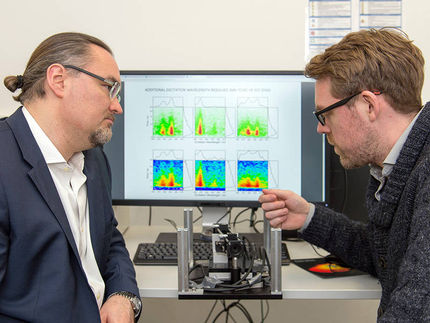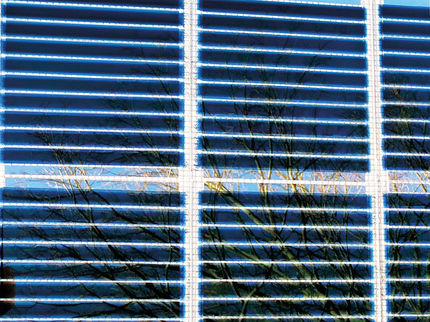Anti-solar cells: A photovoltaic cell that works at night
What if solar cells worked at night? That's no joke, according to Jeremy Munday, professor in the Department of Electrical and Computer Engineering at UC Davis. In fact, a specially designed photovoltaic cell could generate up to 50 watts of power per square meter under ideal conditions at night, about a quarter of what a conventional solar panel can generate in daytime, according to a concept paper by Munday and graduate student Tristan Deppe.

A conventional photovoltaic or solar cell (left) absorbs photons of light from the sun and generates an electrical current. A thermoradiative cell (right) generates electrical current as it radiates infrared light (heat) toward the extreme cold of deep space. UC Davis engineers propose that such cells could generate a significant amount of energy and help balance the power grid over the day-night cycle.
Tristan Deppe/Jeremy Munday
Munday, who recently joined UC Davis from the University of Maryland, is developing prototypes of these nighttime solar cells that can generate small amounts of power. The researchers hope to improve the power output and efficiency of the devices.
Munday said that the process is similar to the way a normal solar cell works, but in reverse. An object that is hot compared to its surroundings will radiate heat as infrared light. A conventional solar cell is cool compared to the sun, so it absorbs light.
Space is really, really cold, so if you have a warm object and point it at the sky, it will radiate heat toward it. People have been using this phenomenon for nighttime cooling for hundreds of years. In the last five years, Munday said, there has been a lot of interest in devices that can do this during the daytime (by filtering out sunlight or pointing away from the sun).
Generating power by radiating heat
There's another kind of device called a thermoradiative cell that generates power by radiating heat to its surroundings. Researchers have explored using them to capture waste heat from engines.
"We were thinking, what if we took one of these devices and put it in a warm area and pointed it at the sky," Munday said.
This thermoradiative cell pointed at the night sky would emit infrared light because it is warmer than outer space.
"A regular solar cell generates power by absorbing sunlight, which causes a voltage to appear across the device and for current to flow. In these new devices, light is instead emitted and the current and voltage go in the opposite direction, but you still generate power," Munday said. "You have to use different materials, but the physics is the same."
The device would work during the day as well, if you took steps to either block direct sunlight or pointed it away from the sun. Because this new type of solar cell could potentially operate around the clock, it is an intriguing option to balance the power grid over the day-night cycle.
Original publication
Other news from the department science

Get the chemical industry in your inbox
By submitting this form you agree that LUMITOS AG will send you the newsletter(s) selected above by email. Your data will not be passed on to third parties. Your data will be stored and processed in accordance with our data protection regulations. LUMITOS may contact you by email for the purpose of advertising or market and opinion surveys. You can revoke your consent at any time without giving reasons to LUMITOS AG, Ernst-Augustin-Str. 2, 12489 Berlin, Germany or by e-mail at revoke@lumitos.com with effect for the future. In addition, each email contains a link to unsubscribe from the corresponding newsletter.





























































